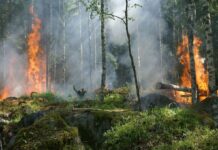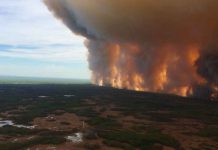Smoke from raging wildfires in Canada blankets the Big Apple, impacting millions of residents and raising health concerns
New York City – New York City has been hit with a dubious distinction as it now ranks as the city with the world’s worst air quality. The culprit behind this alarming situation is the smoke from the raging wildfires in Canada, which has blanketed the city’s skyline and spread to other regions in the northeastern United States and even as far south as South Carolina.
The impact of the smoke has prompted health alerts and air quality warnings, affecting over 75 million residents in the United States. The dire consequences of this environmental crisis are not only unsightly but also pose a significant threat to public health, according to experts in public health, climate, and aerosol sciences.
Naresh Kumar, a professor of public health sciences at the Miller School of Medicine, warns that the emissions from large-scale fires like these are not confined to the areas where they occur. Depending on wind patterns and atmospheric conditions, the smoke can traverse vast distances, putting even healthy individuals at risk. People with allergies, chronic obstructive pulmonary disease (COPD), cardiovascular disease, and asthma face the greatest danger. The resulting health hazards could also lead to additional problems such as stress as people find themselves confined to their homes and disrupted from their normal routines.
Pratim Biswas, dean of the College of Engineering and an expert on aerosol research, emphasizes the need for protective measures against the harmful smoke. Wearing a filter mask, such as the N95 mask, is highly recommended, especially for those who have compromised immune systems or suffer from asthma. While the smoke particles vary in size, they are small enough to penetrate into the lungs, making them hazardous to health. Biswas also highlights the importance of considering the concentration and chemical composition of the smoke particles in understanding their potential harm.
Cassandra Gaston, an associate professor of atmospheric sciences, warns that the smoke from Canada’s wildfires contains a dangerous mixture of gaseous and particle pollutants. Studies have indicated that these smoke particles contain toxic materials, raising concerns about the health risks associated with inhalation. Gaston emphasizes that the smaller particles tend to be more hazardous, and their composition depends on their origin. She cautions against dismissing these environmental issues as distant problems, as atmospheric transport can rapidly spread air pollution from one part of the world to another.
Chang-Yu Wu, a professor of chemical, environmental, and materials engineering, draws attention to the impact of wildfires on climate and future weather patterns. The biological and chemical materials released into the atmosphere during wildfires can affect temperature, moisture distribution, and precipitation patterns. Wu warns that excessive smoke can even prolong drought conditions by trapping moisture in the atmosphere, preventing it from precipitating as rain.
Umer Bakali, a doctoral candidate in biochemistry and molecular biology, highlights the health risks faced by wildland firefighters battling Canada’s blazes. Unlike structural firefighters, these individuals often don’t wear self-contained breathing apparatuses due to the demanding nature of their work in wilderness areas. This puts their respiratory health at greater risk, especially considering the carcinogens present in the wildfire smoke they are exposed to.
Experts agree that with a warming planet, we can expect more frequent and intense wildfires, resulting in massive air pollution events. The impact of wildfires in western states can also be felt across the country as the pollutants are transported eastward.
As New York City grapples with the consequences of being ranked the city with the world’s worst air quality, urgent measures are required to address this crisis and protect the health and well-being of millions of residents.







